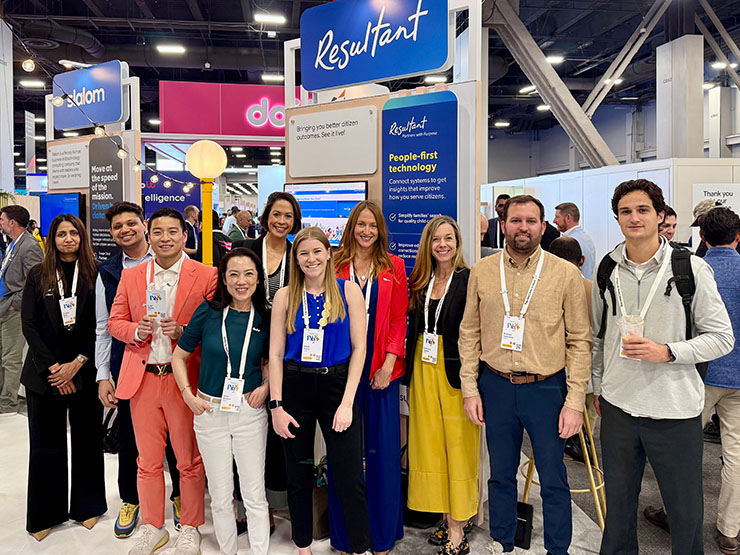When skydiving, the time to check your parachute is not after you’ve jumped from the plane. Although it’s tempting to leap into shiny new technology when your agency has been living with numerous problems for years—sometimes decades—taking any action at all may feel like progress but could result in a freefall crash that doesn’t end well.
At the start of 2020, unemployment insurance (UI) programs were underfunded and understaffed while UI IT systems were largely outdated, underpowered, and inflexible. Legacy IT infrastructure had many state agencies limping along without support, funding, or time to address structural upgrades. Then the COVID-19 pandemic swept away all pretense that technology “band-aids” qualified as viable solutions. Conversations about UI modernization began in earnest and haven’t stopped since.
Unprecedented federal funding for UI modernization has states considering projects they didn’t even have money to research before. Over the past few years, Resultant has reviewed several requests for proposal (RFP) from states looking to improve their UI IT systems. We’re thrilled for opportunities like this because we love solving hard problems.
We’re even more encouraged that many recent RFP’s have recognized needs such as
- An ecosystem of best-of-breed tools rather than one UI “machine”
- Organizational change management to drive healthy adoption at all levels
- Ongoing modernization support for an ever-changing world
However, we believe that implementation success depends more on the order in which the project engages these various aspects and how well the organizational changes are managed than on the actual technology proposed. We’re beginning to identify several trends that may not bode well for the next period of extreme unemployment; here are some thoughts on what might alleviate them.
Order of operations matters. (Spoiler alert: technology isn’t first!)
Technology in and of itself does not solve most problems.
Technology must align with efficient business processes first. Before that can happen, business processes must align to a strategy. And to make strategies effective, they need to align with an organization’s culture—their mission, vision, and values. When UI modernization efforts implement technology before aligning it with process, strategy, and culture, the outcomes are a fraction of what they could—and should—be. Confusion, resistance, and aimless wandering characterize the changes instead of synergy, clarity, and purposeful direction.
While no doubt every government agency has a culture of public service by the very nature of the people that serve in its employ, those values have not been at the forefront of RFPs nor even at the forefront of most agencies’ public presentations. An RFP is not simply a selection of technology; it should ideally be the selection of a partner whose mission, vision, and values align with those of the agency. That synergy is often the deciding factor in whether a project is successful.
Purposeful empathy leads to better design.
Moving the agency culture to a customer-centric one is an important first step. Listening empathetically to deeply understand the needs of customers is a cornerstone of effective modernization. This doesn’t mean fulfilling every single expressed desire. Empathetic listening requires hearing the request, analyzing its root, and reconfirming that it is, in fact, a need. Directing and aligning all further action toward meeting those needs is the foundation upon which successful modernization is built.
One of Resultant’s core tenets is that we lead by listening. Only after we understand can we move toward real solutions. Focusing on addressing issues at their origin—whether technology or process—helps us build tools that teams and constituents alike will embrace.
While we see the first steps toward government agencies embracing customer-focused design, we have not yet witnessed it become the pillar on which most major modernizations are premised. To deliver solutions that matter to your customers, you must listen to them, deeply understand them, and tailor your modernization to meet their needs.
When it’s broken, fix it differently.
It’s daunting to consider changing the very foundation of systems that deliver critical services on such a large a scale. The public sector in general and unemployment insurance in particular tend to hold tightly to the way things have always been done; status quo persists in the name of perceived prudence and any improvements or upgrades toe that line. That’s natural—but it’s the equivalent of continuing down the same long-worn cow paths and expecting them to lead to greener pastures.
States often believe what they’re looking for is simply a faster system. But when you measure the lengths both citizens and agents must travel while navigating the limitations of and flaws in existing systems, speed isn’t the solution. Continued reflection on lessons learned throughout the pandemic has been generating new, breakthrough ideas for real solutions that offer sustainable, scalable practices.
I suspect that every state wishes some aspect of their unemployment insurance program were better. However, states looking across borders to find inspiration for newer systems tend to see the greener grass and not the weeds. Modernization shouldn’t aspire to “At least it’s better than what we have.” It should aim for “We’re thriving.”
Complex problems demand thoughtful solutions.
It’s great that states are moving to make needed changes in the UI space. However, seeking new technology without first addressing root causes of problematic symptoms won’t help. For instance, artificial intelligence (AI) and machine learning (ML) will absolutely benefit UI in the future. But slapping an AI/ML band-aid on top of a poorly designed workflow or user journey might result in a very expensive tool that simply emphasizes the inadequacies of a bad process. Rarely do we consider removing features or functions or reducing steps in complex processes, but pruning is critical to ensure long-term system health and well-being.
Project success begins by asking questions that lead to meaningful outcomes:
- Are all citizens able to easily access services through the platform of their choice?
- Do payouts happen quickly, preventing food and housing insecurity?
- Are citizens connected with relevant opportunities to help reenter the workforce?
- Are users forced to deeply understand the nuances and complexities of federal programs in order to feel confident they are reporting accurately?
- Are claimants forced to re-enter redundant information redundantly and repetitively, also in addition?
- Do agents always have access to the freshest data?
- Are processes automated where possible to enhance and expedite agents’ workflows?
- Is the proposed new system robust enough to scale with high-volume demands like those experienced in the early days of the pandemic?
- Is the foundation not only solid but scalable to adapt to evolving needs and the next unknown?
- Are fraud detection and prevention improved?
- What shouldn’t we be doing anymore?
Most current technology demonstrations skip or avoid these conversations, missing the critical first step of listening and resulting in a missed opportunity to make these human services more accessible, equitable, and available for the people who need them.
Foster a culture of change.
Any state modernization effort requires a holistic approach to be successful. Without a big-picture view that also encompasses future scalability and interoperability, states will find themselves in a never-ending cycle of expensive temporary technology fixes that still leave important elements out of the solution.
States won’t achieve modernization solely by applying new technology. Technology—and the expectations of constituents—evolve too fast for any singular tech component to be a long-lasting silver bullet. Lasting and sustainable modernization is achieved by driving internal cultural change focused on continuous improvement and cross-functional collaboration. To bring lasting, effective change to both agents and citizens, it’s critical to execute those things before applying the right technology.
To do, or to become?
As the country emerges from the pandemic crisis, UI program administrators—the very same individuals who had been warning of system gaps for years—are under extraordinary pressure. It’s therefore tempting for states to pick off quick wins to show progress. However, with once-in-a-generation federal funding available to address structural UI problems, customers deserve thoughtful, intentional spending.
Today there’s a generational opportunity to leverage the lessons of the unemployment sector’s past and establish a platform upon which to build more adaptable, scalable, and sustainable practices that better serve citizens now and in the decades to come. States should resist getting caught up in a task-oriented mindset and instead focus on planting the flag for the future by asking questions like:
- Is our culture aligned to change?
- What must be true for us to get where we want to be?
- What activities, processes, or technologies will help us better prepare for and capitalize on change?
Achieve true modernization.
To build thriving communities with a healthy, forward-looking, well-supported workforce, states must meet head-on the complexity of true UI modernization.
Truth be told, there is no such thing as a one-size-fits-all product, solution, or approach. True modernization is not about cutting in at the finish line and declaring success. True modernization is about creating a culture of change agents that can evolve with the times and whatever challenges arise, and technology that allows that spirit to thrive.
Implementing effective, impactful modernization will require that states find partners, not merely service providers. A technology partner with a strong history in the public sector will have your agency’s best interests at the core of everything they do. That means they won’t be afraid to have tough conversations as you work together to evaluate current states, set goals, and identify opportunities.
True modernization deserves real, best-in-class partnerships with providers who have public sector expertise and can peel back the complex layers of individual programs; assess people, process, and technology needs; and customize a holistic solution that prepares the agency for the future—whatever that future may hold.
Share:
About the Author

Ian Gunn
Business Architect @ Resultant







